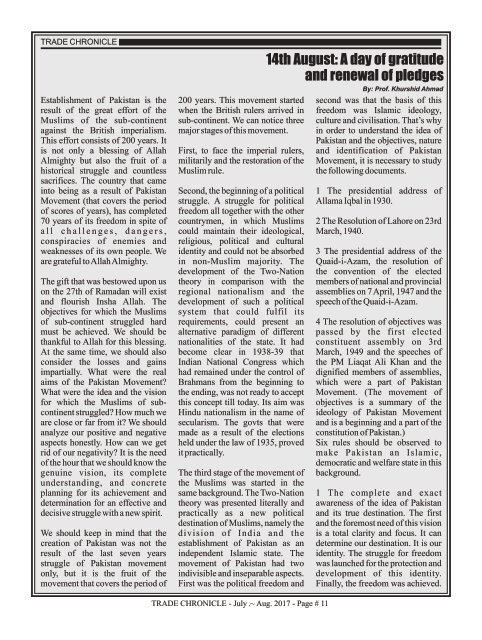Create successful ePaper yourself
Turn your PDF publications into a flip-book with our unique Google optimized e-Paper software.
TRADE CHRONICLE<br />
Establishment of Pakistan is the<br />
result of the great effort of the<br />
Muslims of the sub-continent<br />
against the British imperialism.<br />
This effort consists of 200 years. It<br />
is not only a blessing of Allah<br />
Almighty but also the fruit of a<br />
historical struggle and countless<br />
sacrifices. The country that came<br />
into being as a result of Pakistan<br />
Movement (that covers the period<br />
of scores of years), has completed<br />
70 years of its freedom in spite of<br />
a l l c h a l l e n g e s , d a n g e r s ,<br />
conspiracies of enemies and<br />
weaknesses of its own people. We<br />
are grateful to Allah Almighty.<br />
The gift that was bestowed upon us<br />
on the 27th of Ramadan will exist<br />
and flourish Insha Allah. The<br />
objectives for which the Muslims<br />
of sub-continent struggled hard<br />
must be achieved. We should be<br />
thankful to Allah for this blessing.<br />
At the same time, we should also<br />
consider the losses and gains<br />
impartially. What were the real<br />
aims of the Pakistan Movement?<br />
What were the idea and the vision<br />
for which the Muslims of subcontinent<br />
struggled? How much we<br />
are close or far from it? We should<br />
analyze our positive and negative<br />
aspects honestly. How can we get<br />
rid of our negativity? It is the need<br />
of the hour that we should know the<br />
genuine vision, its complete<br />
understanding, and concrete<br />
planning for its achievement and<br />
determination for an effective and<br />
decisive struggle with a new spirit.<br />
We should keep in mind that the<br />
creation of Pakistan was not the<br />
result of the last seven years<br />
struggle of Pakistan movement<br />
only, but it is the fruit of the<br />
movement that covers the period of<br />
200 years. This movement started<br />
when the British rulers arrived in<br />
sub-continent. We can notice three<br />
major stages of this movement.<br />
First, to face the imperial rulers,<br />
militarily and the restoration of the<br />
Muslim rule.<br />
Second, the beginning of a political<br />
struggle. A struggle for political<br />
freedom all together with the other<br />
countrymen, in which Muslims<br />
could maintain their ideological,<br />
religious, political and cultural<br />
identity and could not be absorbed<br />
in non-Muslim majority. The<br />
development of the Two-Nation<br />
theory in comparison with the<br />
regional nationalism and the<br />
development of such a political<br />
system that could fulfil its<br />
requirements, could present an<br />
alternative paradigm of different<br />
nationalities of the state. It had<br />
become clear in 1938-39 that<br />
Indian National Congress which<br />
had remained under the control of<br />
Brahmans from the beginning to<br />
the ending, was not ready to accept<br />
this concept till today. Its aim was<br />
Hindu nationalism in the name of<br />
secularism. The govts that were<br />
made as a result of the elections<br />
held under the law of 1935, proved<br />
it practically.<br />
The third stage of the movement of<br />
the Muslims was started in the<br />
same background. The Two-Nation<br />
theory was presented literally and<br />
practically as a new political<br />
destination of Muslims, namely the<br />
division of India and the<br />
establishment of Pakistan as an<br />
independent Islamic state. The<br />
movement of Pakistan had two<br />
indivisible and inseparable aspects.<br />
First was the political freedom and<br />
14th <strong>August</strong>: A day of gratitude<br />
and renewal of pledges<br />
By: Prof. Khurshid Ahmad<br />
second was that the basis of this<br />
freedom was Islamic ideology,<br />
culture and civilisation. That’s why<br />
in order to understand the idea of<br />
Pakistan and the objectives, nature<br />
and identification of Pakistan<br />
Movement, it is necessary to study<br />
the following documents.<br />
1 The presidential address of<br />
Allama Iqbal in 1930.<br />
2 The Resolution of Lahore on 23rd<br />
March, 1940.<br />
3 The presidential address of the<br />
Quaid-i-Azam, the resolution of<br />
the convention of the elected<br />
members of national and provincial<br />
assemblies on 7 April, 1947 and the<br />
speech of the Quaid-i-Azam.<br />
4 The resolution of objectives was<br />
passed by the first elected<br />
constituent assembly on 3rd<br />
March, 1949 and the speeches of<br />
the PM Liaqat Ali Khan and the<br />
dignified members of assemblies,<br />
which were a part of Pakistan<br />
Movement. (The movement of<br />
objectives is a summary of the<br />
ideology of Pakistan Movement<br />
and is a beginning and a part of the<br />
constitution of Pakistan.)<br />
Six rules should be observed to<br />
make Pakistan an Islamic,<br />
democratic and welfare state in this<br />
background.<br />
1 The complete and exact<br />
awareness of the idea of Pakistan<br />
and its true destination. The first<br />
and the foremost need of this vision<br />
is a total clarity and focus. It can<br />
determine our destination. It is our<br />
identity. The struggle for freedom<br />
was launched for the protection and<br />
development of this identity.<br />
Finally, the freedom was achieved.<br />
TRADE CHRONICLE - <strong>July</strong> .~ Aug. <strong>2017</strong> - Page # 11

















